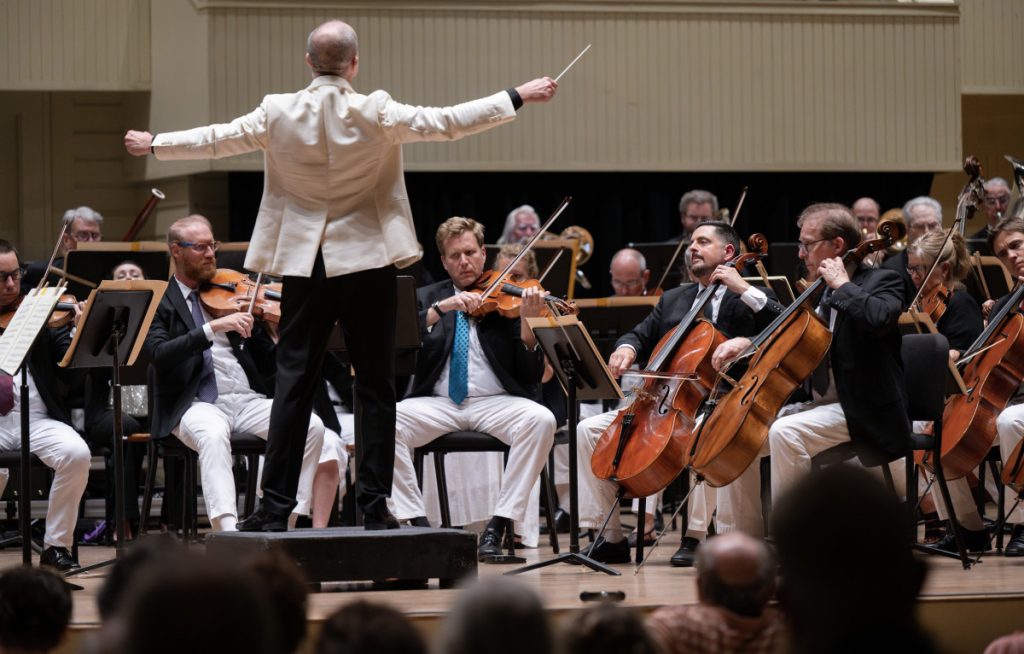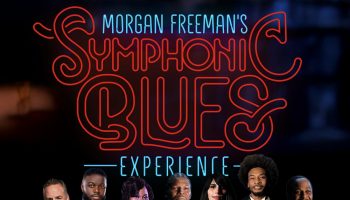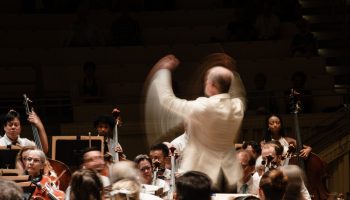
Chautauqua Symphony Orchestra assistant principal cellist Lars Kirvan performs Tchaikovsky’s Symphony No. 4 with his fellow CSO musicians under the baton of Music Director and Principal Symphonic Conductor Rossen Milanov Tuesday in the Amphitheater.

Over his 34-year career, Lars Kirvan has developed what he calls his “cello performance bucket list.” Tonight, he’ll be able to check one of those items off his list with Ernest Bloch’s poignant “Schelomo.”
“(‘Schelomo’ is a) piece that l have always hoped to play with an orchestra some day,” said Kirvan, assistant principal cellist of the Chautauqua Symphony Orchestra. “… The piece itself is inspiring to me because it’s a true expression of what the cello is capable of doing in all its registers. It gives the performer the chance to show off one’s expressive sound and their ability to make music. There’s a ton of emotion and expressivity.”
With Kirvan soloing on the Bloch, the CSO will perform at 8:15 p.m. tonight in the Amphitheater, led by Principal Symphonic Conductor and Music Director Rossen Milanov. In addition to “Schelomo,” the evening’s program includes Brahms’ Symphony No. 2 in D major, op. 73.
“Schelomo” is part of Bloch’s “Jewish Cycle,” and the composer described the work as “the complex, glowing, agitated soul” of the Jewish people. Bloch himself asserted that the cello was the voice of King Solomon; the piece was composed in 1915 and 1916 as the misery of World War I weighed heavily on him.
Following the Bloch, the CSO turns to Brahms’ Second Symphony, composed in the summer of 1877. Notably critical of himself, Brahms often decided he hated a piece, then tear it up and throw it in the fire. He even referred to his Symphony No. 2 as a “charming little monster.”
“What makes Brahms iconic is his writing style and his ability to touch the hearts and minds of people who are listening and really affect them through the chords, progressions, and the way he writes,” Kirvan said. “A lot of these composers were super-idiosyncratic, with all sorts of personal issues; perhaps that contributes to the kind of writing that they choose to compose. It matters what (a composer’s) personality and mentality is like; their music is a direct reflection of that.”
Kirvan began the cello at 10 years old and studied under Loran Stephenson of the National Symphony Orchestra. The young musician hopefully aspired to a career in sports, but “quickly realized athletics couldn’t fulfill (his) dreams.” Kirvan’s decision to play the cello came from the strategic thought that he would be able to sit down with the instrument, as opposed to the violin — which, Kirvan imagined, involved perpetual standing.
Stephenson recognized Kirvan’s talent, and told the 10-year-old’s parents as much, along with the advice that “they needed to push me,” Kirvan said. “So I started working really hard; it was the push from my teacher and parents that got me really practicing, especially in high school.”
From there, Kirvan went to the Cleveland Institute of Music, where he worked closely with Cleveland Orchestra’s principal cellist, Stephen Geber, and then on to the New World Symphony. In 2008, Kirvan became third chair cello with the Rochester Philharmonic Orchestra; he joined the CSO in 2015. His wife, violinist Liana Kirvan, also plays with both orchestras.
“When (Liana and I) started dating, she was doing her substitution position with the Chautauqua Symphony, so I could get a taste of what it was like there. I decided to take the audition when it was open for cello,” Kirvan said. “When we had our first child, we thought this would be a really nice place to be for the summertime — a good change of pace from Rochester. We weren’t wrong about it and never regretted our decision to take our lives out to Chautauqua.”
When Kirvan plays, even in front of a large audience, he feels “enveloped” in the sound of his instrument and what he’s conveying to his listeners.
“I’m making sure that what I want to say is easily understood to whomever I’m playing it for,” Kirvan said. “I work a lot on my sound production and sound quality, the technical aspects behind everything.”
There may be parallels — with the Week One theme of “The Evolution of the Modern Presidency” — between expressing oneself democratically and expressing oneself musically. There’s a contemplative nature to the music being performed, and how “everyone is going to interpret it very differently,” Kirvan said.
“Since the world is ever-evolving and changing — or not — it’s up to us as individuals to express ourselves as we see fit. In a democratic situation, we have our own opinions that should be made valid at the ballot boxes in the same way as we as musicians put our own touches and expressions on music to make the pieces sound different from previous generations,” he said. “As in politics, music evolves as well. We just have to see what works, what sticks, and what doesn’t — but we have choices.”




